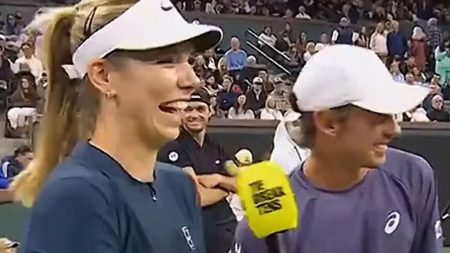Wimbledon Stands by 14-Day Format
Wimbledon, the most iconic of the four Grand Slam tennis tournaments, has made it clear that it will not be following the other majors in adopting a 15-day tournament format. The US Open recently announced its shift to a weekend start, aligning with the Australian Open and French Open, which have already adopted this schedule. This change means that for the first time in the Open era, these tournaments will have 15 consecutive days of action. However, Wimbledon, known for its strict adherence to tradition, remains committed to its 14-day format. Former British No.1 Tim Henman, who now serves on the All England Club board, emphasized that the decision to keep the tournament at 14 days is rooted in the unique challenges of maintaining the grass courts. Henman explained that the courts, especially Centre Court, are heavily used throughout the tournament and need to be in top condition for the final weekend. Extending the tournament to 15 days would put an additional strain on the courts, which could compromise the quality of play and the overall experience for both players and spectators.
Historical Context and Grass Court Maintenance
In 2022, Wimbledon scrapped the traditional middle Sunday rest day, opting for continuous play across the entire tournament. This change was already a significant departure from the club’s long-standing traditions, with the middle Sunday being used primarily for watering the courts to ensure they remained in optimal condition for the latter stages of the tournament. Henman highlighted the irony of the 11pm curfew, which has been a unique feature of Wimbledon for years, effectively giving the tournament a "bedtime." Despite the initial skepticism, the 11pm deadline has proven to be beneficial, preventing matches from extending into the early hours of the morning and ensuring that players and spectators alike can maintain their schedules. The decision to keep the tournament at 14 days is also a practical one, considering the 80 hours of tennis played on Centre Court alone. The board’s stance is firm: they see no appetite for a 15-day format, primarily due to the challenges it would pose to the grass courts.
No Plans for Coaching Pods
While Wimbledon is sticking to its 14-day format, it is also making another notable decision: it will not introduce the coaching pods that have been a recent innovation at the Australian Open. These swivel chairs allow players to communicate with their coaches during matches, providing a new level of interaction and support. Andy Murray, a former Wimbledon champion, was seen using this system to chat with Novak Djokovic during a break in play, a moment that captured the attention of fans and media alike. However, Wimbledon has no plans to adopt this technology, primarily due to space constraints on Centre Court. Henman noted that the prestigious venue simply does not have the room for such an innovation. This decision underscores Wimbledon’s commitment to maintaining the integrity and tradition of its matches, even as other tournaments explore new ways to enhance the player experience.
Embracing Electronic Line Calling
One of the most significant changes at Wimbledon this year is the adoption of electronic line calling, which will replace the line judges who have been a part of the tournament for 147 years. The All England Club will use Hawk-Eye Live, an AI technology, for all qualifying and main draw matches. This system promises greater accuracy and consistency in calls, which can speed up play and reduce the potential for controversy. Henman acknowledged that this decision was not made lightly, especially considering the historical significance and the unique atmosphere line judges bring to the courts. However, he also pointed out that the ATP Tour is moving toward electronic line calling across all of its tournaments from 2025, and Wimbledon’s refusal to comply would have made it an outlier. The club’s adoption of this technology is a step toward modernization and maintaining its prestigious status in the tennis world.
The Impact on Line Judges
The transition to electronic line calling at Wimbledon is not without its downsides. Approximately 300 line judges, ranging in age from 18 to 80, have traditionally covered over 650 matches at the tournament. These officials, dressed in their iconic Ralph Lauren outfits, have been more than just functional; they have been part of the tournament’s charm and atmosphere. Their roles have often provided mild entertainment, with dramatic calls of "fault" and the occasional dodgeball moment when a powerful serve narrowly misses them. Beyond the immediate impact on Wimbledon, this change could have broader ramifications for British tennis. Many of these line judges work part-time and aspire to officiate at higher-level tournaments, with Wimbledon serving as a pinnacle goal. Without the incentive of working at Wimbledon, fewer officials might be willing to take on the lower-level tournaments, potentially hindering the development of British tennis umpires and referees. Henman recognized this concern but ultimately believes the technological upgrade is the right move for the tournament.
Djokovic’s Wimbledon Prospects
Despite the changes, the focus remains on the players, and one of the most anticipated returns is that of Novak Djokovic. Henman, who has closely followed Djokovic’s career, believes that the Serbian tennis great has his best shot at winning a 25th Major on the grass courts of Wimbledon, where he has been the singles champion seven times. Djokovic’s performance last year, reaching the final despite undergoing knee surgery, was a testament to his resilience and skill. Henman is keen to see how Djokovic manages his schedule leading up to the tournament, noting that as the player gets older, balancing match experience with the need to stay fresh becomes increasingly challenging. Wimbledon’s grass courts, which have historically favored Djokovic’s style of play, could be the key to his success in achieving this milestone. The tournament’s unique format and surface will undoubtedly play a crucial role in the upcoming competition.
Maintaining Tradition and Embracing Innovation
Wimbledon’s decisions reflect a delicate balance between maintaining its rich traditions and embracing necessary innovations. The club’s resistance to a 15-day format and coaching pods demonstrates its commitment to preserving the unique character of the tournament, while the adoption of electronic line calling shows its willingness to adapt to the modern era of tennis. This approach ensures that Wimbledon remains a premier event in the sports calendar, respected for both its history and its forward-thinking practices. The All England Club’s board, including Henman, is well aware of the broader impact their decisions have on the tennis ecosystem, but they are confident that these changes will benefit the tournament in the long run. As Wimbledon prepares for the 2023 Championships, it stands as a testament to the enduring appeal of grass court tennis, blending tradition with technological advancement to provide a world-class experience for players and fans alike.











